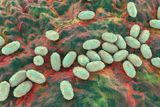‘Patchy’ nanoparticles emerge from new atomic stencilling technique
Researchers in the US and Korea have created nanoparticles with carefully designed “patches” on their surfaces using a new atomic stencilling technique. These patches can be controlled with incredible precision, and could find use in targeted drug delivery, catalysis, microelectronics and tissue engineering.
The first step in the stencilling process is to create a mask on the surface of gold nanoparticles. This mask prevents a “paint” made from grafted-on polymers from attaching to certain areas of the nanoparticles.
“We then use iodide ions as a stencil,” explains Qian Chen, a materials scientist and engineer at the University of Illinois at Urbana-Champaign, US, who led the new research effort. “These adsorb (stick) to the surface of the nanoparticles in specific patterns that depend on the shape and atomic arrangement of the nanoparticles’ facets. That’s how we create the patches – the areas where the polymers selectively bind.” Chen adds that she and her collaborators can then tailor the surface chemistry of these tiny patchy nanoparticles in a very controlled way.
A gap in the field of microfabrication stencilling
The team decided to develop the technique after realizing there was a gap in the field of microfabrication stencilling. While techniques in this area have advanced considerably in recent years, allowing ever-smaller microdevices to be incorporated into ever-faster computer chips, most of them rely on top-down approaches for precisely controlling nanoparticles. By comparison, Chen says, bottom-up methods have been largely unexplored even though they are low-cost, solution-processable, scalable and compatible with complex, curved and three-dimensional surfaces.
Reporting their work in Nature, the researchers say they were inspired by the way proteins naturally self-assemble. “One of the holy grails in the field of nanomaterials is making complex, functional structures from nanoscale building blocks,” explains Chen. “It’s extremely difficult to control the direction and organization of each nanoparticle. Proteins have different surface domains, and thanks to their interactions with each other, they can make all the intricate machines we see in biology. We therefore adopted that strategy by creating patches or distinct domains on the surface of the nanoparticles.”
“Elegant and impressive”
Philip Moriarty, a physicist of the University of Nottingham, UK who was not involved in the project, describes it as “elegant and impressive” work. “Chen and colleagues have essentially introduced an entirely new mode of self-assembly that allows for much greater control of nanoparticle interactions,” he says, “and the ‘atomic stencil’ concept is clever and versatile.”
The team, which includes researchers at the University of Michigan, Pennsylvania State University, Cornell, Brookhaven National Laboratory and Korea’s Chonnam National University as well as Urbana-Champaign, agrees that the potential applications are vast. “Since we can now precisely control the surface properties of these nanoparticles, we can design them to interact with their environment in specific ways,” explains Chen. “That opens the door for more effective drug delivery, where nanoparticles can target specific cells. It could also lead to new types of catalysts, more efficient microelectronic components and even advanced materials with unique optical and mechanical properties.”
She and her colleagues say they now want to extend their approach to different types of nanoparticles and different substrates to find out how versatile it truly is. They will also be developing computational models that can predict the outcome of the stencilling process – something that would allow them to design and synthesize patchy nanoparticles for specific applications on demand.
The post ‘Patchy’ nanoparticles emerge from new atomic stencilling technique appeared first on Physics World.


















